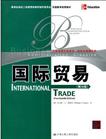国际贸易
出版时间:2009-7 出版社:中国人民大学出版社 作者:托马斯·A.普格尔 页数:371
Tag标签:无
前言
随着我国加入WTO,越来越多的国内企业参与到国际竞争中来,用国际上通用的语言思考、工作、交流的能力也越来越受到重视。这样一种能力也成为我国各类人才参与竞争的一种有效工具。国家教育机构、各类院校以及一些主要的教材出版单位一直在思考,如何顺应这一发展潮流,推动各层次人员通过学习来获取这种能力。双语教学就是这种背景下的一种尝试。双语教学在我国主要指汉语和国际通用的英语教学。事实上,双语教学在我国教育界已经不是一个陌生的词汇了,以双语教学为主的科研课题也已列入国家“十五”规划的重点课题。但从另一方面来看,双语教学从其诞生的那天起就被包围在人们的赞成与反对声中。如今,依然是有人赞成有人反对,但不论是赞成居多还是反对占上,双语教学的规模和影响都在原有的基础上不断扩大,且呈大发展之势。一些率先进行双语教学的院校在实践中积累了经验,不断加以改进;一些待进入者也在模仿中学习,并静待时机成熟时加入这一行列。由于我国长期缺乏讲第二语言(包括英语)的环境,开展双语教学面临特殊的困难,因此,选用合适的教材就成为双语教学成功与否的一个重要问题。我们认为,双语教学从一开始就应该使用原版的各类学科的教材,而不是由本土教师自编的教材,从而可以避免中国式英语问题,保证语言的原汁原味。各院校除应执行国家颁布的教学大纲和课程标准外,还应根据双语教学的特点和需要,适当调整教学课时的设置,合理选择优秀的、合适的双语教材。顺应这样一种大的教育发展趋势,中国人民大学出版社同众多国际知名的大出版公司,如麦格劳一希尔出版公司、培生教育出版公司等合作,面向大学本科生层次,遴选了一批国外最优秀的管理类原版教材,涉及专业基础课,人力资源管理、市场营销及国际化管理等专业方向课,并广泛听取有着丰富的双语一线教学经验的教师的建议和意见,对原版教材进行了适当的改编,删减了一些不适合我国国情和不适合教学的内容;另一方面,根据教育部对双语教学教材篇幅合理、定价低的要求,我们更是努力区别于目前市场上形形色色的各类英文版、英文影印版的大部头,将目标受众锁定在大学本科生层次。本套教材尤其突出了以下一些特点:·保持英文原版教材的特色。本套双语教材根据国内教学实际需要,对原书进行了一定的改编,主要是删减了一些不适合教学以及不符合我国国情的内容,但在体系结构和内容特色方面都保持了原版教材的风貌。专家们的认真改编和审定,使本套教材既保持了学术上的完整性,又贴近中国实际;既方便教师教学,又方便学生理解和掌握。·突出管理类专业教材的实用性。本套教材既强调学术的基础性,又兼顾应用的广泛性;既侧重让学生掌握基本的理论知识、专业术语和专业表达方式,又考虑到教材和管理实践的紧密结合,有助于学生形成专业的思维能力,培养实际的管理技能。
内容概要
本书是根据我国本科“国际贸易”课程双语教学的需要,选取国外经典的原版教材《国际经济学》(第14版)中国国际贸易部分的内容改编而成。其第12版于2005年由中国人民大学出版社引进出版英文版后,被越来越多的高校采用,在双语教学中取得了良好的效果。 第14版为最新版,保持了原著简明易懂、既注重严谨的经济分析,又强调经济政策导向的特点,并紧跟国际贸易理论与实践的发展动态,进行了增补和更新,补充了对近几年来一些重要事件的分析(如石油价格动荡、金价上涨);增加了“全球治理”专栏;特别新增了“聚焦中国”专栏;更新了案例及部分章节内容。 本书篇幅适中,定价合理,非常适合本科双语教学使用,同时也可作为广大国际贸易工作者的参考书。
作者简介
作者:(美国) 托马斯·A.普格尔 (Thomas A.Pugel) 托马斯·A·普格尔(Thomas A.Pugel) 美国纽约大学斯特恩商学院经济学及国际商务学教授,拥有密歇根州立大学经济学学士学位和哈佛大学经济学博士学位。现任斯特恩商学院优秀教师评选委员会委员。其主要研究及著作领域为国际产业竞争及政府的国际贸易政策和产业政策。普格尔教授曾任日本青山学院客座教授,并在中国工业科技管理大连培训中心任教。他于1991年荣获纽约大学杰出教学奖,并两次被斯特恩商学院评选为“年度教授”。
书籍目录
第1章 国际经济学是一门独特的学科第1篇 国际贸易理论 第2章 国际贸易的基本理论:需求与供给 第3章 人们为什么要进行贸易:比较优势 第4章 贸易:要素有效性和要素比例是关键 第5章 在国际贸易中谁获益,谁受损? 第6章 规模经济、不完全竞争与贸易 第7章 贸易与经济增长 第2篇 贸易政策 第8章 对关税的分析 第9章 非关税进口壁垒 第10章 支持与反对贸易保护的论点 第11章 推动出口 第12章 贸易集团与贸易禁运 第13章 贸易与环境 第14章 发展中国家的贸易政策 第15章 跨国公司与移民:国际要素流动 附录A 网络与图书馆:国际数据与其他信息的来源 附录B 生产可能性曲线的推导附录C 提供曲线附录D 国家最优关税习题参考答案
章节摘录
插图:The supply curve shows the lowest possible price at which some producer would be willing to supply each unit. Producers actually receive the going market price for these units. Producers who would have been willing to supply at a lower price benefit from selling at the market price. Indeed, we can measure how much their well-being increases. To see this, consider first the total (variable) costs of producing and selling the total quantity that is actually supplied. We can measure this cost unit by unit. For the first motorbike supplied into the market, the supply curve in Figure 2.1B tells us that some producer would be willing to supply this for about $400, the price just above where the supply curve hits the axis. This amount just covers the extra cost of producing and selling this first unit. The supply curve tells us that some producer is willing to supply the second motorbike for a slightly higher price, because the extra cost of the second unit is a little higher, and so on. By adding up all of the supply curve heights for each unit supplied, we find that the whole area under the supply curve (up to the total quantity supplied) is the total cost of producing and selling this quantity of motorbikes. For instance, the total cost of producing 15,000 motorbikes is equal to area z in Figure 2.1B. This total cost can be measured as a money amount, but for the whole economy it ultimately represents an opportunity cost——the value of other goods and services that are not produced because resources are instead used to produce this product (motorbikes). The total revenue received by producers is the product of the market price and the quantity sold. For instance, at a price of $1,000 per motorbike, producers sell 15,000 motorbikes, so they receive $15 million in total revenue (equal to area e + z). Because producers would have been willing to supply some motorbikes at a price below $1,000, receiving the going market price for all units results in a net gain in their economic well-being. The net gain is the difference between the revenues received and the costs incurred. This net gain is called producer surplus, the increase in the economic well-being of producers who are able to sell the product at a market price higher than the lowest price that would have drawn out their supply. For a market price of $1,000 in Figure 2.1B, the producer surplus is the difference between total revenues (area e + z) and total costs (area z). Producer surplus is thus equal to area e, the area above the supply curve and below the price line.
编辑推荐
《国际贸易(第14版)》是由中国人民大学出版社出版的。
图书封面
图书标签Tags
无
评论、评分、阅读与下载
用户评论 (总计34条)
- 很好的一本书,双语言读本,正在学习中,感觉不错,国际贸易的理论知识不错。
- 英文版看着头疼而已
- 老师推荐的教材,很不错
- 刚开始看以为是经济学呢,不过还好,阅读上没有很大的障碍。
- 上课指定用书,内容很好
- 不错的一本书……
- 我是个大学生,这本书对我非常有用,不仅巩固了专业课还提高了英语阅读能力
- 质量很好,是正版,值得购买
- 便宜!正版,好
- 资料很好,很有帮助
- 当阅读或者写作范文都是不错的选择
- 书的质量很好满意
- 送货速度快 书面印刷很好 纸张摸起来很舒服
- 挺好的,折扣太少了,其他地方也能买到
- 好,一如既往的好
- 我的课本啦。。不得不买哟。。
- 还不错啦。就是书比想象的大
- 英文版可能比较有挑战,但是作为教材很受欢迎
- 看着还好,希望有用
- 商品描述是中英双语,实际上是全英文版的。对于一般的学习者来说,不宜读,不太实用。
- 麻烦问下 我专业课用这本书 不过不知道里面是不是英文的 我要买全英的
- 全英文的,不过目录是双语的。我很喜欢,能学到很多知识。
- 这本书得英文功底深厚才好看。
- 书的好多地方都弄脏了,黑乎乎的,还有一个角磨损很厉害,封皮也有弄皱,反正感觉就像旧书似的,而且快递很烂,服务超差
- 班级里同学定的,用着很好。
- 发货速度快,书的质量也非常好!赞一个!
- 很不错的教材,如果完全保持其原貌不删减就好了。
- 书都是新的,内容齐全
- 一直在亚马逊买书的,这本书还没看,翻了下,质量还是不错的,清华出品还比较有保障的。
- 我们学校的教材,质量不错~
- 很实用,不过里面都是英文,需要查字典
- 坑爹啦,里面全是英文,木有中文啊,让留学生情何以堪啊!!!!
- 书本不错,是正版的,物流也很满意。
- 心急,想拿到书本来阅读,好像,amazon的承诺服务不到位。。。。。
推荐图书
- 保险法论
- 香港对外贸易发展研究
- 法文化与构建社会主义和谐社会
- 实用会展英语
- 北宋烟云-重现中国历史-19-图文漫画版
- 金戈铁马-重现中国历史-20-图文漫画版
- 精忠报国-重现中国历史-21-图文漫画版
- 一代天骄-重现中国历史-22-图文漫画版
- 一年级语文
- 大国问号
- 餐馆楼面管理
- 厚黑学中的做人哲学
- 从侍应到主管
- 资本主义经济增长的逻辑
- 金融危机的政治经济学分析
- 财会技能鉴定与竞赛指南
- 语文
- 基于中国股票市场的制度与行为金融研究
- 剑桥雅思全真试题7终极解析
- 民主理论的前言(扩充版)
- 汽车用橡胶制品标准手册
- 中外钢材实用技术手册 上卷 钢棒 线材 型钢 铸钢
- 建筑施工选材手册
- 2008版ISO9000族标准质量管理体系内部审核培训教程
- 国家标准化管理委员会统一宣贯教材 国家认证认可监督管理委员会推荐培训教材 GB/T 27404-2008《实验室质量控制规范 食品理化检测》理解与实施
